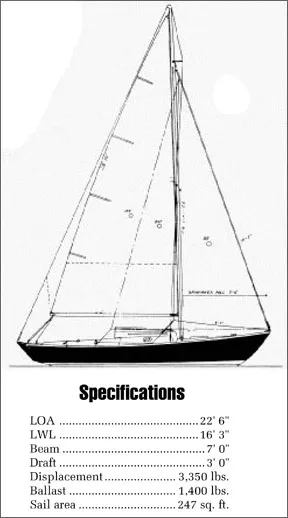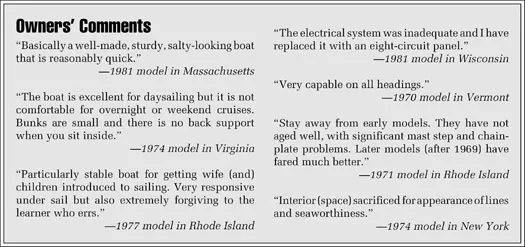The Sea Sprite 23 is a trim but rugged daysailer-overnighter from naval architect Carl A. Alberg that enjoyed a 25-year production run under several different Rhode Island builders, most notably Clarke Ryder. It’s a typical Alberg design—narrow beam, full keel and conservative ballast-to-displacement ratio and graceful lines. This is a boat that still turns heads when it sails into a harbor.

History
The origins of the Sea Sprite 23 go back to 1958 when the small American Boat Building company of East Greenwich, Rhode Island, wanted to expand its product line, consisting at the time of the Block Island 40. Carl Alberg, then in the U.S. Coast Guard, came up with a 22 1/2-foot, full-keel design. (We’re not sure what Alberg’s duties were in the Coast Guard, but they apparently left plenty of free time; besides the Sea Sprite, Alberg also drew the Pearson Triton and Bristol 27 while in the service.) The Sprite, incidentally, was first marketed as a 22; a later builder accentuated the positive and it became the 23.
American Boat Building employee Tom Potter Remembers being asked to test sail the new design. “We were terribly impressed by the boat, the way it performed.” It was, Potter said, typical of most of the boats Alberg would design over the years—”sensible boats you could take to sea.”
When American Boat Building dissolved during the early 1960s, production of the Sea Sprite was taken over by the nearby Wickford Shipyard, which built it for several years, after which the molds passed briefly to Sailstar, another small Rhode Island company, then to Clint Pearson, who was starting up his own Bristol Boat Company across Narragansett Bay.
Earlier, cousins Clint and Everett Pearson had obtained the rights to the Triton, which American Boat Building for some reason had not wanted. But when Bristol employee Paul Coble designed the Corsair 24, the rights to the Sea Sprite were sold to another Bristol builder, Clarke E. Ryder. This was about 1974, and Ryder continued to build the 23 until 1985 when his company folded.
Ryder built new molds for the boat, encapsulating the heretofore external lead keel and creating a self-bailing cockpit. Except for a few other minor changes and the introduction of hull colors besides white—bright red, blue and green—the Sea Sprite 23 built by Ryder (he began with hull #525) was fundamentally the same as the first off the line at American Boat Building. All told, the model reached a run of nearly 800 before Ryder closed the doors on this highly successful boat.
The Design
Like most of Alberg’s boats, the 23 is relatively narrow of beam (7′ 0″) and heavily ballasted—43 percent of its weight is in the full keel. Freeboard and superstructure are low, which makes for pleasing lines but less than spacious accommodations below. In short, this is a boat designed for sailing and not lounging around belowdecks.
With a waterline length of just 16′ 3″, the boat rated well (16.6) under the old Cruising Club of America (CCA) rules. It is intended to heel 30 degrees or so when underway (some regard this as initial tenderness), adding waterline length and increasing hull speed. The heeling angle plus the low freeboard—the rail gets close to the water—can bring an occasional dousing for the crew in a chop. But the boat is inherently stable, and the gentle sheer and distinctive overhangs add to its seagoing profile. The 23 draws only three feet, virtually shoal draft and less than many smaller boats.
Under the more modern PHRF rating system, which is a performance-based handicap system rather than a measurement rule, the Sprite has an average rating of about 270 seconds per mile—hardly a rule-beater, but reasonably fast for a full-keeled 23-footer. (One owner crowed about beating those “tubby” Cape Dorys—in all likelihood a competing Alberg design.)
The Sprite carries a modest 247 square feet of sail under main and working jib. (The newer O’Day 23, by contrast, is lighter by almost 300 pounds and has 246 square feet.) Early in its career, the Sea Sprite also came in a daysailer model, with an eight-foot cockpit instead of the standard six, and with two berths below instead of four, and no galley or icebox. Apparently few were made, which is understandable because the standard model has ample cockpit space and little enough room below.
Construction
The hull, deck and cabinhouse of the Ryder-built boats are solid, hand-laid fiberglass for a tight, sound body. One owner called the boat “overbuilt.” The hull/deck joint is a typical inward flange sealed with 3M 5200 and fastened with machine screws.
Most fiberglass boats older than 10 to 15 years show deterioration of the gelcoat and require painting. This will be true of many used Sea Sprites, too. None of the owners who responded to our survey reported gelcoat blistering, however. Some of the earlier models seemed to experience slight leaks around the mast step or chainplates; several of the Ryder boats apparently had leaking from the pulpit stanchions. Otherwise, the interiors are reported to be dry. Overall, the Sea Sprites seem to be structurally sound with no major repairs called for and few, if any, cosmetic problems. A 1983 model we sailed looked almost new.
The Sea Sprite was built as a top-of-the-line “sailing yacht,” as company literature described it. The quality shows in the non-skid surfaces on the deck and deckhouse, the standard bronze hardware, including opening portlights, and in the generous use of wood—mahogany coamings and backrest and teak grabrails above, and lots of teak trim below. Ryder introduced a full interior liner (previous models were painted fiberglass), and the judicious use of holly and teak helps offset the shiny white surfaces. We don’t know whether the Sea Sprite’s teak cockpit grids were standard on all models, but they are a nice touch.

The boats, at least the Ryder version, carry a 30- foot fractionally rigged mast by Hall Spars. The mast is deck-stepped and halyards are led internally. The small deckhouse makes for a roomy foredeck, which is reached via comfortably wide walkways.
Performance
Several of our readers say the Sea Sprite exhibits fairly sluggish light-air performance, which is a common complaint among smaller full-keel boats. Others have found that raising a 130- or 150-percent genoa in winds under 10 knots makes a definite improvement.
Performance improves noticeably as the wind pipes up and the boat digs in. Although the rail is near the water, the boat, once in its sailing mode, seems very stable and the steering nicely balanced with just a hint of weather helm. The low freeboard enhances the feeling of being on the water which, for a small-boat enthusiast at least, is worth the occasional spray in a head sea. And while the keel-hung rudder doesn’t respond as rapidly as a spade would, the 23 tacks smartly enough. One owner, who now sails a J/Boat, remembered his Sea Sprite’s tacking ability as “not unreasonably slow.”
This is a small boat that handles well when the going gets rough and goes readily offshore—no worries about early reefing here. One owner we know said he “never thought twice” about sailing his Sea Sprite to Block Island or Cuttyhunk. In fact, Ryder used to tout a transatlantic trip—60 days from Wickford, Rhode Island to Falmouth, England—made in 1974 by a 21-year-old singlehander as evidence of the boat’s ocean-going qualities. (The only damage—to the skipper—occurred when he tripped on the dock in England and broke his ankle.)
Moving under power, however, is another matter. A 4-hp outboard, which is located in a well aft of the tiller, will get the boat to hull speed; anything smaller is a strain, more than 6 hp and you may experience control problems. The outboard well is the usual nuisance and several readers surveyed either had banished the motor below or would like to. The best that can be said for the well is that it preserves the lines of the boat. Outboard performance is inversely proportionate to wind and waves. Having once fought a losing battle against gusting winds, tide and current, with ground speed reduced to about zero, we can attest to the Sea Sprite’s poor performance under power in these conditions. If only the channel had been wide enough to hoist the sails….
Ryder for a time offered an optional Yanmar Model 1 GM diesel. This would no doubt eliminate many of the headaches associated with the outboard motor and well, but the weight and expense of an inboard seems difficult to justify. None of the readers responding to our questionnaire own inboard models.
Interior
Down below, the cabin is light and reasonably airy with two opening ports and a smoked hatch. Despite some complaints about the lack of room (even Clarke Ryder says the interior is best suited for stowing stuff) we found there was satisfactory sitting headroom if you are under six feet. The 6′ 0″ V-berths are too short and have minimal clearance; the 6′ 3″ settee berths in the main cabin disappear quickly under the cockpit seats. This is an interior that is definitely not for the claustrophobic, but at least you won’t need lee cloths. The marine head (many owners have replaced it with a portable head) is located in a wedge at the foot of the V-berths where its virtual inaccessibility makes the privacy issue moot. To be fair, this is typical of the arrangements on most boats of this size.
To starboard, between the forward and main berths, is the “galley,” consisting of a sink and some stowage. To port, there’s an insulated icebox and more dry storage. The sink, fed by a 10-gallon fiberglass water tank under the starboard berth, drains via a through-hull. The icebox drains into the bilge. There’s more stowage, under bunks and here and there, but it’s basically covered openings to the bilge. On deck, there’s good storage space in a port locker and a fuel locker to starboard that’s sized for a three-gallon tank.
Conclusions
The Sea Sprite 23 isn’t for everyone. A lack of space and accommodations relegates it to the daysailer/occasional overnighter category. Although it lacks cruising luxuries, it is an exceptional daysailer—seaworthy and strongly built, and with a sailing range that belies its small size. Its stability and ease of handling make it a good choice for the older sailor who doesn’t need a big boat anymore, or for a small family primarily interested in day sailing.
We saw several Sea Sprites listed for sale this past fall (1991) in the $6,500 range—a good price for a well-built boat that’s going to be around for a while. Older Sprites originally sold for $5,000 (minus sails) with the later Ryder models going for about $11,000.
The Sprites can be said to have held their value well while still representing a bargain relative to what you get. As Clarke Ryder says, “They sail like a charm and they’re pretty. People who have them love them.”




































